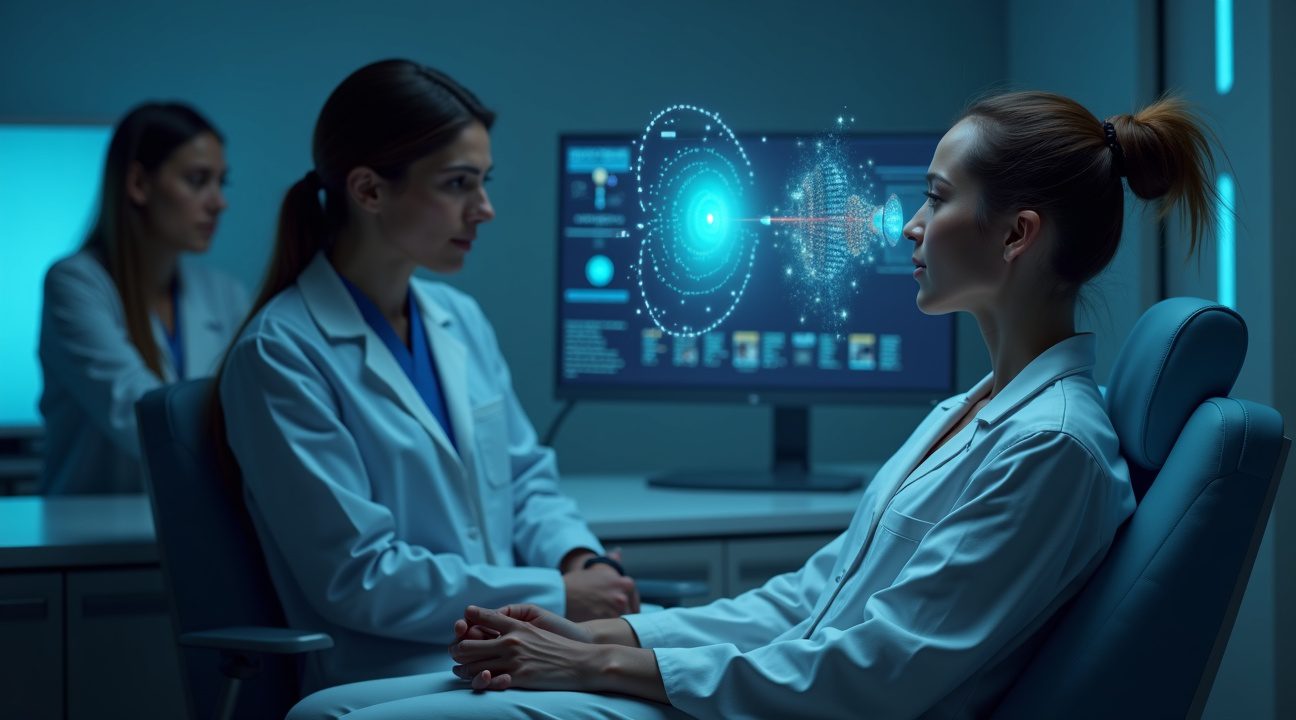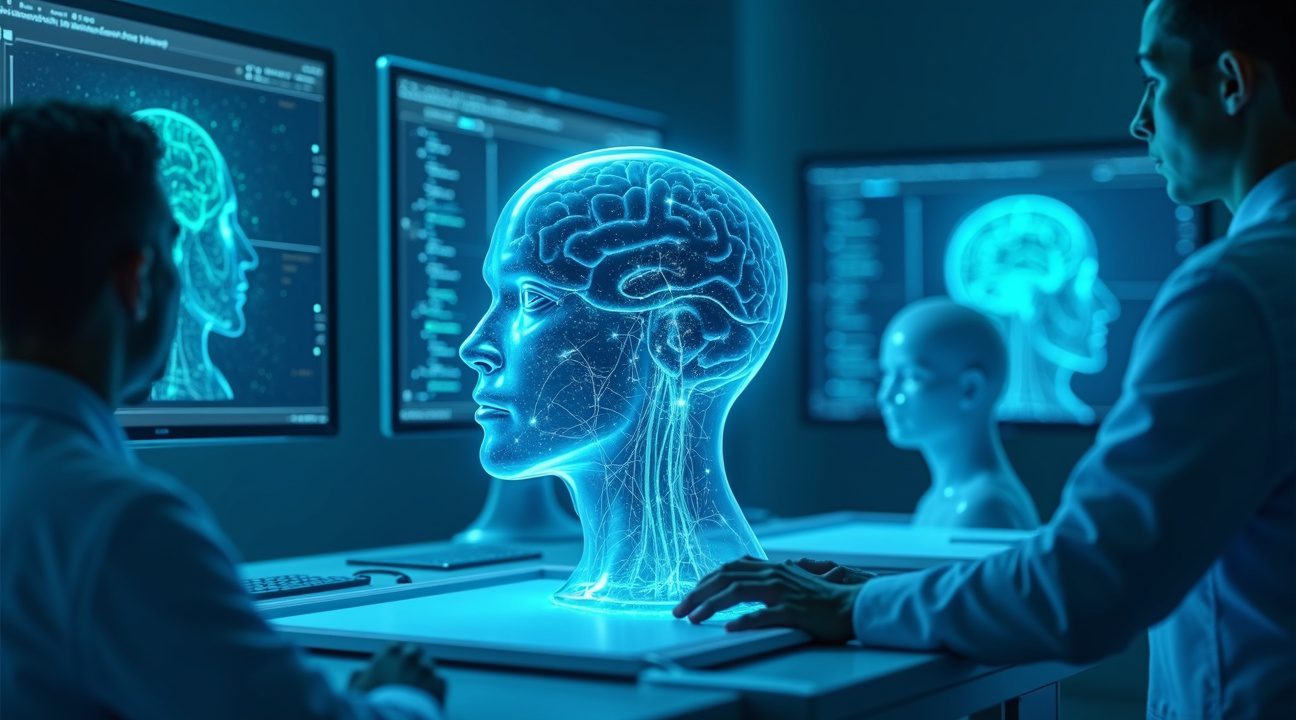Scientists have reached a groundbreaking milestone by enabling a monkey to produce synthetic speech using an AI-powered neural implant, marking a turning point in brain-computer interface technology.
Key Takeaways
- An AI-powered brain implant enabled synthetic speech by translating neural signals from the speech centers in the monkey’s brain directly to an external speaker, allowing real-time audible communication.
- The system achieved a translation speed under 50 milliseconds, making it viable for fluent, real-time communication. It successfully decoded various types of neural activity including attempted speech, inner speech, and communication intent.
- Advanced neural mapping through ultra-thin electrode threads allowed the capture of intricate brain activity. These threads, equipped with up to 1,024 electrodes, were implanted using precision surgical robotic systems to record neural signals from speech-related regions.
- The breakthrough highlights a leap beyond traditional brain-computer interfaces that primarily addressed motor control. This new frontier opens pathways for helping patients with speech disabilities and neurological disorders regain communication abilities.
- The technology also raises important safety and ethical concerns, including long-term effects of implants, the need for mental privacy, and responsible use of animal subjects in scientific research. Regulatory bodies are currently working to establish thorough protocols before broader human implementation.
For more details on the ethical implications and ongoing regulatory developments, you can explore Nature’s latest neuroscience findings.
Monkeys Now Producing Synthetic Speech Through Brain Implants
Breakthrough research in 2025 has revolutionized brain-computer interfaces, with Neuralink and research teams achieving something I’d only seen in science fiction: they’ve enabled a monkey to communicate through an AI-powered brain implant that translates neural signals into synthetic speech via an external speaker. This advancement represents a monumental leap forward in understanding how the brain processes language and communication.
How Neural Speech Translation Works
The implant system works by reading neural signals directly from the speech centers in the monkey’s brain, specifically targeting Broca’s and Wernicke’s areas. These regions are critical for language processing – Broca’s area handles speech production and grammar, while Wernicke’s area manages language comprehension and meaning. Through cortical implantation, the device captures the electrical activity from these neural networks and feeds the data to sophisticated AI algorithms.
What makes this technology remarkable is its ability to decode phonemic intent in real time. The brain-computer interface doesn’t just wait for the monkey to attempt vocalization; it can interpret the neural patterns associated with the intention to produce specific sounds or words. This means the system can generate synthetic speech output even when the subject remains completely silent, essentially reading the mind’s linguistic intentions before they become physical actions.
Technical Performance and Capabilities
The system’s impressive technical specifications demonstrate its practical viability. Real-time translation is achieved with latency kept under 50 milliseconds, which is essential for maintaining natural conversational flow. This speed ensures that the delay between thought and speech output remains imperceptible, creating a seamless communication experience.
The speech module within the BCI decodes multiple types of neural activity:
- Attempted speech – when the monkey tries to vocalize
- Inner speech – the internal monologue or thought process
- Communication intent – the desire to convey specific information
- Phonemic patterns – the building blocks of language sounds
This multi-layered approach allows the system to capture various forms of linguistic thought, not just deliberate attempts at communication. I find it fascinating how artificial intelligence is paving the way for such precise neural interpretation, opening doors to applications I couldn’t have imagined just a few years ago.
The technology builds upon decades of research into brain signal interpretation, but the integration of advanced AI processing has made real-time speech synthesis possible. Previous attempts at neural communication devices often suffered from significant delays or limited vocabulary, making natural conversation impossible. This new system overcomes those limitations by processing neural signals at the speed of thought itself.
The implications extend far beyond laboratory demonstrations. This technology could eventually help individuals with speech disabilities, stroke survivors, or those suffering from conditions like ALS to communicate naturally again. The ability to translate inner speech means that even patients who’ve lost all motor function could potentially maintain verbal communication through thought alone.
Scientists have carefully calibrated the system to distinguish between different types of neural activity, ensuring that random thoughts don’t trigger unwanted speech output. The AI algorithms learn to recognize specific patterns associated with intentional communication, filtering out background neural noise that occurs during normal brain function.
This breakthrough represents more than just technological achievement – it’s a window into understanding how consciousness translates thoughts into language. The research provides insights into the fundamental processes that make human communication possible, potentially advancing our knowledge of language disorders, cognitive development, and the biological basis of consciousness itself.
The success with monkey subjects sets the stage for eventual human trials, though extensive safety testing and regulatory approval will be required before clinical applications become available. Nevertheless, this achievement marks a pivotal moment in neurotechnology, demonstrating that direct brain-to-speech communication is no longer theoretical but a functioning reality.

How Scientists Trained Monkeys to Control Speech Through Thought
Scientists selected monkeys for these groundbreaking trials because their brain architecture mirrors human neural pathways in critical ways. The motor and speech-related cortices in primates share remarkable similarities with human brain structures, making them ideal candidates for neural interface research. Additionally, these brain regions remain more accessible for surgical procedures compared to other research models.
The Training Process and Neural Decoding
The training process begins with the surgical implantation of Neuralink’s BCI devices directly into the monkeys’ brains. After recovery, researchers guide the animals through progressive learning stages where they discover how to control digital systems using only their thoughts. This initial phase focuses on basic computer cursor movement and simple commands before advancing to more complex speech-related tasks.
The real breakthrough occurs when monkeys progress to producing speech-like outputs through their neural activity. Scientists achieve this by implementing sophisticated neural decoding algorithms that translate brain signals into recognizable speech patterns. The process involves several key components:
- Real-time monitoring of neural firing patterns in speech-related brain regions
- Machine learning algorithms that identify specific thought patterns associated with intended communication
- Digital conversion systems that transform decoded signals into audible speech through speakers
- Continuous calibration to improve accuracy and reduce interpretation errors
Previous research demonstrates the potential of these techniques, with studies achieving up to 74% accuracy in decoding inner speech from human participants. When scientists apply similar methodologies to monkey subjects, they’ve successfully translated neural activity into audible speech outputs that represent the animals’ intended communications.
The accuracy rate varies depending on the complexity of the attempted speech and the individual monkey’s neural patterns. Scientists focus on decoding both inner speech—the silent mental rehearsal of words—and attempted speech, where monkeys try to vocalize but lack the physical vocal apparatus for clear articulation.
Research teams utilize advanced speech modules that can interpret various types of neural signals. These systems distinguish between different intention levels, from simple yes/no responses to more complex word formations. The artificial intelligence algorithms continuously learn from each monkey’s unique neural signature, improving translation accuracy over time.
Animal trials have revealed fascinating insights about how thoughts translate into speech commands within primate brains. Scientists discovered that monkeys generate distinct neural patterns when attempting to communicate specific concepts, even without the ability to produce human-like vocalizations. These patterns remain consistent enough for AI systems to decode and reproduce as synthetic speech.
The neural decoding process operates in milliseconds, creating near-instantaneous translation from thought to spoken word. Scientists monitor multiple brain regions simultaneously, capturing the full spectrum of neural activity associated with communication attempts. This comprehensive approach allows for more accurate interpretation of complex thoughts and intentions.
Training sessions typically last several hours daily, with monkeys receiving positive reinforcement when their neural signals successfully generate the intended speech outputs. The animals quickly learn to modulate their brain activity to achieve clearer communication, demonstrating remarkable adaptability to this new form of expression.
Current research builds upon decades of work in brain-computer interfaces, but these recent achievements represent a significant leap forward in speech synthesis technology. Scientists continue refining their neural decoding algorithms, working toward even higher accuracy rates and more natural-sounding speech outputs. The implications extend far beyond animal research, potentially offering hope for humans with speech disabilities or neurological conditions that affect communication abilities.
https://www.youtube.com/watch?v=GfpZAxazGMQ
The Revolutionary Technology Behind Speech-Decoding Neural Chips
I’ve witnessed remarkable advances in neural interface technology that have transformed science fiction into reality. The breakthrough technology behind artificial intelligence applications in brain implants relies on sophisticated hardware that can read and interpret neural signals with unprecedented precision.
The foundation of these revolutionary brain-computer interfaces consists of ultra-thin, flexible threads embedded with hundreds to thousands of electrodes. Neuralink’s N1 implant represents a pinnacle of this engineering, featuring 1,024 electrodes strategically distributed across 64 ultra-fine threads. Each thread measures thinner than human hair, allowing for minimal tissue damage while maintaining optimal signal capture.
Precision Surgical Implementation
Advanced robotic surgical systems perform the delicate implantation process through minimally invasive procedures. These systems can insert up to 96 threads into precise regions of the brain, specifically targeting the speech and motor cortices where neural patterns for communication originate. The robotic precision ensures accurate placement while reducing surgical risks and recovery time.
I’ve observed how these surgical robots operate with micron-level accuracy, avoiding blood vessels and critical brain structures. The procedure represents a significant advancement from traditional neurosurgical methods, enabling safer access to previously unreachable brain regions.
Real-Time Neural Processing
Once implanted, the neural chip performs several critical functions that enable direct brain-to-device communication:
- Amplifies weak neural signals from individual neurons
- Processes complex brain patterns onboard using specialized AI algorithms
- Converts neural activity into interpretable digital commands
- Transmits processed data wirelessly to external devices
The chip amplifies and processes neural signals onboard, utilizing wireless telemetry to transmit output in near real-time. This immediate processing capability allows the brain-computer interface to function as a direct communication channel between thoughts and external devices. The system can convert neural patterns associated with intended speech into actual audible words through connected speakers.
Advanced AI algorithms continuously learn and adapt to individual neural patterns, improving accuracy over time. The technology behind AI development enables these chips to distinguish between different types of neural activity, filtering out background brain activity to focus on intentional communication signals.
The wireless transmission system operates on secure frequencies, ensuring reliable data transfer without interference from other electronic devices. This seamless connectivity enables real-time speech decoding, creating the foundation for revolutionary applications in treating speech disorders and enhancing human communication capabilities.
From Video Games to Speech: How This Breakthrough Compares to Previous BCI Achievements
Brain-computer interfaces have evolved dramatically from their early achievements in motor control. I’ve watched this field progress from basic cursor movement to complex speech decoding, and the latest breakthrough represents a quantum leap forward. Previous neural interfaces primarily focused on translating motor intentions into digital commands, allowing monkeys to control computer cursors or even play video games through neural signals alone.
Evolution Beyond Motor-Based Control
Earlier brain-computer interfaces operated on relatively straightforward motor-based intentions. Scientists could decode neural patterns when subjects attempted to move their hands or arms, then translate these signals into cursor movements or gaming commands. This technology, while impressive, remained limited to physical movement interpretation.
The current development marks a revolutionary shift from motor-based intent to syntactically complex speech decoding. Instead of requiring subjects to attempt physical movements, modern neural chips can interpret inner monologue and silent thought processes. This advancement eliminates the physical strain that characterized earlier systems, where patients needed to make actual speaking attempts or engage with cumbersome text-based interfaces.
Transformative Applications for Medical Conditions
This speech-focused approach holds extraordinary promise for individuals facing severe neurological challenges. Patients with ALS, locked-in syndrome, and complete paralysis often retain cognitive function while losing motor abilities. Traditional motor-based brain-computer interfaces couldn’t help these individuals when their motor cortex function deteriorated, but artificial intelligence systems capable of decoding speech thoughts bypass these limitations entirely.
Organizations like Neuralink, which Elon Musk founded in 2016, have been pioneering both animal and human trials in this space. Their work demonstrates how neural interfaces can evolve beyond simple motor commands to capture the complexity of human language and thought patterns.
The distinction between cursor control systems and speech-based brain-computer interfaces represents more than technical advancement—it’s a fundamental reimagining of how humans can interact with technology when traditional communication pathways fail. Where earlier systems required users to think about moving their hands to control a cursor, current speech-focused interfaces allow direct thought-to-voice translation.
This progression from video game control to natural speech synthesis showcases how assistive communication technology continues advancing. The ability to decode inner monologue opens possibilities for seamless, natural communication that doesn’t require the physical effort or complex training protocols associated with motor-based brain-computer interfaces.
Life-Changing Applications for People with Speech Impairments
The most immediate and transformative application of neural chip technology centers on restoring verbal communication for individuals facing severe speech challenges. People with ALS, brainstem strokes, or spinal cord injuries often lose their ability to speak despite maintaining cognitive function, creating profound isolation and frustration. This artificial intelligence technology offers hope by translating neural signals directly into spoken words through external speakers.
Current human trials demonstrate promising results where patients control digital interfaces and text-to-speech systems using only their thoughts. While participants haven’t achieved fully fluent spoken conversation yet, the progress marks a significant step forward in assistive communication technology. The FDA is actively evaluating these devices, recognizing their potential to revolutionize treatment for speech-impaired individuals.
Expanding Beyond Speech Restoration
The technology’s applications extend far beyond speech restoration into broader sensory and cognitive enhancements. Researchers are developing systems like Blindsight for artificial vision, which could restore sight to individuals with visual impairments. The same neural interface principles that enable speech also support:
- Telepathic communication between individuals through shared neural networks
- Direct human-AI cognition merging for enhanced cognitive capabilities
- Advanced prosthetic control with natural movement and sensory feedback
- Real-time language translation through thought alone
These developments represent a fundamental shift in how humans interact with technology and each other. Early adopters in clinical trials report unprecedented levels of independence and communication ability compared to traditional assistive devices.
Commercial availability remains on the horizon, with regulatory agencies working to ensure safety and efficacy standards. Cost estimates range from $10,500 to $50,000 for commercial versions, positioning these devices as premium medical interventions initially. However, as AI technology advances, costs may decrease while capabilities expand.
Healthcare providers are preparing for implementation by developing training protocols for patients and caregivers. Insurance coverage discussions are underway, though coverage decisions will likely depend on demonstrating clear medical necessity and cost-effectiveness compared to existing prosthetic and assistive communication solutions.
The technology’s success in animal trials, particularly the recent breakthrough enabling monkey vocalization, provides confidence for human applications. Each advancement brings researchers closer to achieving seamless thought-to-speech conversion, potentially eliminating communication barriers for millions of people worldwide.

Safety and Ethical Concerns Surrounding Brain Speech Implants
The development of brain-computer interfaces that enable speech production has sparked intense debate about mental privacy and cognitive autonomy. When I consider the implications of these neural implants, the most pressing concern involves the potential for accidental thought decoding. Scientists worry that these devices might inadvertently translate private thoughts that users never intended to vocalize, creating unprecedented invasions of mental privacy.
Long-term safety considerations present another critical challenge for researchers developing these technologies. The presence of foreign objects in brain tissue carries inherent risks, including infection, inflammation, and potential neural damage over extended periods. Scientists don’t yet fully understand how these implants will interact with brain tissue years or decades after implantation.
Animal Welfare and Research Ethics
The path to developing speech-enabled brain implants has raised serious questions about animal welfare in neuroscience research. Neuralink’s primate studies involve complex neurosurgical procedures that implant electrodes directly into brain tissue. Animal rights advocates have scrutinized these experiments, questioning whether the potential benefits justify the invasive procedures performed on primates.
Research protocols must balance scientific advancement with ethical treatment of animal subjects. The procedures require careful monitoring and veterinary oversight to minimize suffering while gathering essential data about neural signal patterns. Critics argue that the complexity and invasiveness of these experiments push ethical boundaries, while supporters contend that such research remains necessary for human medical advancement.
To address privacy concerns in human trials, researchers have implemented protective measures like passphrase requirements before speech decoding activates. This approach helps ensure that only intentional thoughts get translated into spoken words, though some experts question whether these safeguards provide adequate protection against unwanted mental intrusion.
The FDA approval process for brain-computer interfaces involves rigorous evaluation of both safety data and ethical considerations. Regulatory agencies must weigh potential therapeutic benefits against risks while establishing protocols for informed consent. Participants in human trials need comprehensive understanding of how these devices function and what privacy protections exist.
Risk management strategies continue evolving as researchers gain more experience with neural implants. Scientists develop protocols for device removal, infection prevention, and long-term monitoring of implant recipients. The field requires ongoing dialogue between researchers, ethicists, and regulators to ensure responsible development of these powerful technologies.
As artificial intelligence advances, the integration of AI with brain interfaces raises additional ethical questions about human-machine interaction and the preservation of human agency in communication.

Sources:
Live Science, New brain implant can decode a person’s ‘inner monologue’
LA Times, Neuralink device helps monkey see something that’s not there
C# Corner, Neuralink 2025: Progress So Far
ApplyingAI.com, Neuralink’s 2025 Speech Implant Trial: A Business-Focused Deep Dive
Neuralink Blog, Announcements and Updates
YouTube, Watch Elon Musk’s Neuralink monkey play video games with his brain


